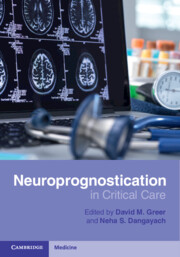Book contents
- Neuroprognostication in Critical Care
- Neuroprognostication in Critical Care
- Copyright page
- Epigraph
- Contents
- Contributors
- Chapter 1 Shared Decision Making
- Part I Disease-Specific Prognostication
- Chapter 2 Prognostication in Intracerebral Hemorrhage
- Chapter 3 Prognostication in Acute Ischemic Stroke
- Chapter 4 Prognostication in Subarachnoid Hemorrhage
- Chapter 5 Prognostication in Traumatic Brain Injury
- Chapter 6 Prognostication in Spinal Cord Injury
- Chapter 7 Prognostication in Cardiac Arrest
- Chapter 8 Prognostication in Neuroinfectious Disease
- Chapter 9 Prognostication in Neuromuscular Disease
- Chapter 10 Prognostication in Status Epilepticus
- Chapter 11 Prognostication in Fulminant Hepatic Failure
- Chapter 12 Prognostication in Post-Intensive Care Syndrome
- Chapter 13 Prognostication in Sepsis-Associated Encephalopathy
- Chapter 14 Prognostication in Delirium
- Chapter 15 Prognostication in Neuro-Oncology and Neurological Complications of Hemato/Oncological Diseases
- Chapter 16 Prognostication in the Complications of Neurosurgical Procedures
- Chapter 17 Prognostication in Pediatric Neurocritical Care
- Part II Other Topics in Neuroprognostication
- Index
- References
Chapter 15 - Prognostication in Neuro-Oncology and Neurological Complications of Hemato/Oncological Diseases
from Part I - Disease-Specific Prognostication
Published online by Cambridge University Press: 14 November 2024
- Neuroprognostication in Critical Care
- Neuroprognostication in Critical Care
- Copyright page
- Epigraph
- Contents
- Contributors
- Chapter 1 Shared Decision Making
- Part I Disease-Specific Prognostication
- Chapter 2 Prognostication in Intracerebral Hemorrhage
- Chapter 3 Prognostication in Acute Ischemic Stroke
- Chapter 4 Prognostication in Subarachnoid Hemorrhage
- Chapter 5 Prognostication in Traumatic Brain Injury
- Chapter 6 Prognostication in Spinal Cord Injury
- Chapter 7 Prognostication in Cardiac Arrest
- Chapter 8 Prognostication in Neuroinfectious Disease
- Chapter 9 Prognostication in Neuromuscular Disease
- Chapter 10 Prognostication in Status Epilepticus
- Chapter 11 Prognostication in Fulminant Hepatic Failure
- Chapter 12 Prognostication in Post-Intensive Care Syndrome
- Chapter 13 Prognostication in Sepsis-Associated Encephalopathy
- Chapter 14 Prognostication in Delirium
- Chapter 15 Prognostication in Neuro-Oncology and Neurological Complications of Hemato/Oncological Diseases
- Chapter 16 Prognostication in the Complications of Neurosurgical Procedures
- Chapter 17 Prognostication in Pediatric Neurocritical Care
- Part II Other Topics in Neuroprognostication
- Index
- References
Summary
Metastatic brain tumors, which include both primary metastatic disease that initiated within the central nervous system (CNS) and secondary metastatic disease that started systemically and metastasized to the CNS, are collectively the most prevalent types of intracranial tumor.[1] Standardized treatment including surgery followed by either focal or whole-brain radiation have allowed for excellent local control rates.[2,3] In the setting of neurological complications related to these tumors, much work has been done to understand the key markers of prognostic and predictive significance. In addition, improved mortality rates in cancer patients have come at the cost of increasingly complicated treatment regimens including cytotoxic, immunological, surgical, and radiation-based therapies. Underlying heterogeneity across different types of metastatic brain disease is a contributing factor to this challenging decision-making process. In addition, only the presence or absence of brain metastasis at the time of initial diagnosis is noted in many historical studies, decreasing the overall detection of metastatic brain disease that develops later in the disease course.
- Type
- Chapter
- Information
- Neuroprognostication in Critical Care , pp. 219 - 228Publisher: Cambridge University PressPrint publication year: 2024

